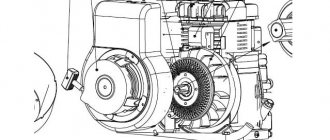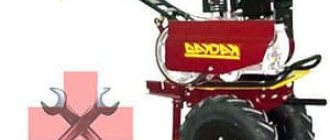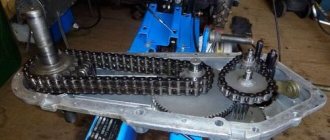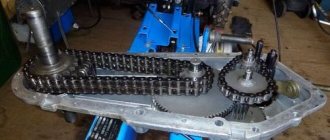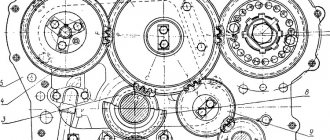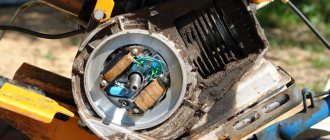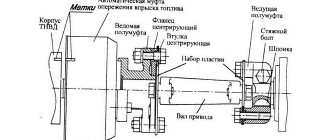PUMA ESS Jersey Polo
1726 ₽ More details
PUMA ESS Jersey Polo
1726 ₽ More details
Pants PUMA
The ignition system in the walk-behind tractor is checked and adjusted regularly. This allows you to quickly and efficiently start the system. Spark plugs for the Neva walk-behind tractor have their own characteristics. The ignition system of a walk-behind tractor is an important part of the mechanism and requires constant maintenance. This allows you to avoid most breakdowns and malfunctions.
Don't forget about the ignition system in the walk-behind tractor
Design of the ignition system on a walk-behind tractor
Today, more and more people use walk-behind tractors on their plots.
This is not surprising, because such equipment can do absolutely everything: plow the ground, plant and harvest potatoes, transport cargo, and even remove snow. However, like any other machines, walk-behind tractors sometimes break down and require repair. In this article we will look at the ignition system of a walk-behind tractor, the types of its breakdowns, how to eliminate them, as well as the process of adjusting the ignition. And if the cause of the malfunction lies precisely here, it will not be difficult for you to eliminate it.
Setting up the walk-behind tractor ignition system
The ignition system is a very important design that ensures the formation of a spark in the internal combustion chamber to ignite the air-fuel mixture. In order not to encounter breakdowns and not to call a repairman, you need to know how to correctly set the ignition on the walk-behind tractor. This can be done in different ways.
- Thanks to the spark. Do the following:
- Turn the crankshaft so that the pulley mark and the mark located at the base of the timing mechanism coincide. In this case, the interruption-distribution slider should point to the high-voltage wire of one of the cylinders;
- loosen the nut that positions the body of the mechanism that determines the moment of creation of high-voltage pulses;
- from the system cover, which determines the moment of creation of high-voltage pulses, you need to remove the high-voltage wire located in the center, and place its contact at a distance of 5 millimeters from the “ground” of the walk-behind tractor;
- now turn on the ignition;
- the body of the mechanism that determines the moment of creation of the above-mentioned impulses must be turned clockwise to the 200 mark;
- now slowly turn your body in the opposite direction;
- the position of the mechanism should not change, but at the same time you will see a spark between the contact located in;
- tighten the breaker nut.
- Using your hearing:
- start the engine;
- Unscrew the nut that holds the distributor base a little;
- the interrupter housing must be slowly rotated on both sides;
- the state of the mechanism, which determines the appearance of high-voltage pulses, must be fixed in the position when the motor power is the highest and the speed is the highest. Listen carefully;
- turn the breaker body clockwise;
- Now firmly fasten the distributor fastening element;
- Using a strobe:
- heat the walk-behind tractor engine to a state optimal for operation;
- connect the power supply of the strobe to the network of your unit;
- the sensor, which is designed to trigger the sound, must be placed on the high-voltage electrical wire of one of the cylinders;
- remove the vacuum correction hose and plug it;
- the light from the strobe should be directed towards the pulley;
- start the engine. It should run at idle speed;
- rotate the distributor body;
- create the fastening when the pulley mark is directed to the mark on the cover of the device;
- tighten the fixing nut.
Carburetor problems
The carburetor of the walk-behind tractor may be dirty, and in many cases it may not be adjusted correctly. If this happens, then such a unit is removed and cleaned, its adjustment is carried out, which should be provided for by the rules:
- Another problem may arise, which is expressed in the fact that air does not flow into the carburetor in full. This can happen due to a clogged air filter; ultimately, the fuel mixture comes out over-rich. During use, you should periodically clean the special filter to prevent such problems from occurring. However, if the equipment is used in very dusty conditions, more frequent cleaning may be necessary.
- You should consider the condition of your air filter. Depending on the material in the base, it is necessary to rid the part of dirt using one of the effective methods. If the carburetor of the device begins to receive air in small quantities, then it may be necessary to clean the paper filter, which is done by lightly tapping or blowing.
- If you have a foam filter, you can wash it and then dry it completely. The mesh filter can be cleaned with a vacuum cleaner. Such parts have their own expiration date; as soon as it is used up, the unit will need to be replaced.
Breakdowns and ways to fix them
If your walk-behind tractor stops starting, perhaps the reason is in the ignition system. There may be several reasons:
- malfunction in the ignition coil;
- in a spark plug for a walk-behind tractor;
- in the tip of the candle;
- in the wire.
To check the spark plug, you need to unscrew it and examine the central and side electrodes. If carbon deposits are found on it, it can be easily removed using a gas burner.
How to check the coil (magneto)? Exactly the same as a candle. You need to put a tip on the spark plug, and bring the lower part to the magneto body. If you rotate the flywheel and there is no spark, then the failure is in the coil.
Many owners of walk-behind tractors are often interested in the question, which spark plug is better? As practice and knowledge of specialists show, the one with the shorter heat removal path is better. Such a part will not overheat and will last much longer.
As you can see, the ignition system is quite easy to repair. It is only important to start repairs on time. Also, do not forget to periodically clean the spark plug, which will significantly extend its service life.
Neva walk-behind tractor engine
The main working unit of a walk-behind tractor is the engine. It is activated only by turning the key; if the Neva walk-behind tractor does not start, then there are several possible reasons.
The walk-behind tractor does not start
No spark
In this case, it is necessary to check its functionality. Remove the spark plug from the engine and insert it into a special candle holder, and place the housing on the cylinder. Next, turn on the engine. If there is no spark, then you can replace the spark plug; if it does not appear, you should check the starting mechanism and ignition operation. Most often, it is the start button that fails; it can be replaced with a new one.
How to remove a candle correctly?
A special key is used to remove the spark plug. You must be careful, because the spark plug heats up during operation, so remove the spark plug before starting or after the walk-behind tractor engine has cooled down. We install a new one, and then check the clearance. It must be, but not big. The recommended lumen width is 0.5-0.6 mm.
Gasoline does not reach the engine
The second reason that the engine does not start is a problem in the supply of the fuel mixture. In this case, you should go through the complete gasoline delivery scheme. From the fuel tank to the carburetor.
- First check if there is fuel in the gas tank. It should not only be, but be 2-3 cm higher than the bottom, since the gas tank in the Neva walk-behind tractor is designed in such a way that fuel is taken at exactly this height.
- If there is fuel, you should check the operation of the gasoline intake valve. To do this, remove it from the hose and look, if gasoline flows out, then everything is fine, if not, you can clean the tap itself or replace it with a new one.
- Next, check the hose that connects the faucet to the carburetor. Remove it and try to blow it out. If air flows freely, it is functioning well. If not, clean it or replace it.
- And the last in this chain is the carburetor. Disassemble it and thoroughly wash all parts with 95 gasoline. Thanks to this, carbon deposits and impurities will be washed off. After completing the work, thoroughly blow all joints and joints with a compressor to minimize residual gasoline, which evaporates under air pressure. After this, put all the parts back together.
Motoblock structure, engine diagram
The design of the carburetor of the Cascade walk-behind tractor is shown in Figure 2.
Tuning (adjustment) of the carburetor of the Cascade walk-behind tractor is carried out according to the standard scheme:
- the engine must warm up;
- then the position of the throttle valve is changed using the adjusting screw;
- after this, the idle speed is reduced to a minimum, the operator must achieve a uniform sound from the engine;
- then the maximum and minimum engine speeds are adjusted three to four times until the sound is smooth and stable at the selected throttle position.
Ignition of the "Cascade" walk-behind tractor
Sometimes the problem of starting and operating a walk-behind tractor lies in the ignition itself. The ignition adjustment of the Cascade walk-behind tractor is performed based on the engine type. Each engine comes with an instruction manual, so it needs to be studied in detail.
- The engine starting mechanism - the starter - is designed to spin the crankshaft.
- The electronic ignition system ensures uninterrupted sparking at the spark plug.
Basic recommendations for adjusting/operating the ignition of the “Cascade” walk-behind tractor:
- use the following types of spark plugs: BP6ES, BPR6ES(NGK) or NHSPLDF, this way you can avoid the appearance of soot;
- carry out maintenance of the spark arrester every 100 operating hours (cleaning the soot from the mesh filter);
- The idle speed for the engines of the Cascade walk-behind tractor is 1700 (+-150) rpm.
Gearbox of walk-behind tractor "Cascade"
The gearbox is mechanical, chain. The clutch and manual transmission are the basic components of a transmission and are often housed in a special unit.
The output shaft of the reinforced gearbox is located on bearings with a significant diameter, which are resistant to mechanical damage and the negative influence of various types of vibrations.
Figure 3. Diagram of the “Cascade” gearbox
Oil seals (cuffs) of the "Cascade" walk-behind tractor
Oil seals provide engine sealing, protect against engine oil leakage and are installed in special places in the rotating parts of the engine. The oil seal is installed on the shaft and its working edge tightly fits the working surface of the shaft. The oil seal can be replaced yourself.
The replacement process is very simple:
- the cutters are removed from the shaft and cleaned of dirt and dust, then the cover mounting bolts are removed, and the cover itself is removed.
- After that, the worn out oil seal is removed, a new one is installed in its place, and sealant is applied to the connector.
- Dimensions of oil seals "Cascade": 42/28/7 (shaft 30 mm).
- The gearbox bearing of the Cascade walk-behind tractor has dimensions 941/20 (26*20*14 mm).
- The clutch of the "Cascade" walk-behind tractor is dry type. The clutch mechanism works by tensioning the V-belt drive belts.
Belts of the walk-behind tractor "Cascade" - tension, dimensions, tension rollers
The Cascade unit has two types of belts: forward and reverse. Type of forward belts: A-1180 or A-1213 GOST 1284; type of reverse belts: A-1400. The "A" value is 13 mm. Diameter of tension rollers: external - 92 mm, internal - 12 mm.
Motoblocks today are perhaps one of the most popular agricultural machinery, which has found its application both in farming and in summer cottages. These units will efficiently process any soil in a fairly short time without much difficulty. Everyone knows that any technology tends to fail. This also applies to walk-behind tractors. Now we will analyze several cases of breakdowns of the Cascade walk-behind tractor and give short instructions for eliminating them.
Read also How much propolis is needed for half a liter of vodka
Carburetor, malfunctions, adjustment
Below is an algorithm for setting up a carburetor on a Neva walk-behind tractor with a Subaru engine.
The diagram shows three screws that are responsible for the amount of fuel supplied.
- Screw 1 - number of full throttle revolutions;
- Screw 2 - number of idle speeds;
- Screw 3 - responsible for idling.
To adjust the carburetor, you must perform the following manipulations:
- Tighten screws 1 and 2 until they stop;
- Then unscrew them about 1 turn;
- Turn on the ignition and warm up the engine;
- Then place the throttle control lever until the engine is turned off (that is, until the speed is at a minimum level);
- Set the minimum idle speed level with the third screw;
- Then set the maximum idle speed with the second screw;
- If necessary, adjust the minimum speed again by adjusting the position of the third screw;
- Carry out the last two steps until stable engine operation is obtained;
- If there are interruptions, tighten the first screw again until it stops and unscrew it one and a half turns.
Attachments
The most popular attachments are hillers and plows. The first is necessary to add soil. A plow is also needed to cultivate the area.
The potato digger (KHM) can dig up root crops at a depth of up to 225 mm. Strip processing width 26 cm. Dimensions 562x372x542 mm Weight up to 5.5 kg.
The CB 1/1 hitch weighs only 5.4 kg, dimensions 436x132x176 mm and works with the following units:
- hiller;
- plow
- potato digger;
- lugs Ф342х112 mm;
- the mower for the Neva walk-behind tractor can cover a strip up to 1200 mm wide, the height of the grass that the unit can mow is 42 mm;
- snow removal equipment;
- potato planter;
- reversible plow;
- snow blower;
- wide rake.
Gearbox, faults, device
The gearbox is designed to transmit rotation that comes from the engine to the wheels and attachments. It regulates the speed and direction of movement.
Gearbox device
The gearbox is designed in such a way that to regulate its operation there is no need to disassemble the entire mechanism. All regulators are located on the outside.
The gearbox has 5 positions. When you press the lever, the clutch is disengaged; when it is released, it returns to its place.
If the drive is connected to the right axle shaft, then at this moment of switching the walk-behind tractor stops. When the handle is recessed, the left sprocket catches and the gear shifts down. If it is necessary to increase the gear, the handle moves forward.
Major gearbox failures
- The clamps or springs have failed. In this case, they should be replaced with new ones;
- The settings of the gearbox itself have gone wrong. Loosen the screws, set the first gear, and tighten it back;
- Oil appears on the shaft. The main reason for this behavior is the failure of the cuff. It needs to be replaced with a new one. It is also recommended to replace the seals. To do this, just pry off the old ones, pull them out and install new ones;
- The transmission is jammed. There's a problem with the chain. It should be inspected and, if its integrity is damaged, replaced with new ones;
- The transfer is not recorded. Most likely the fork is worn out. It cannot be repaired, only replaced with a new one.
- Grinding noise in the gearbox. Most often it occurs with increased loads on the walk-behind tractor. This indicates that the gearbox axle shaft has failed, or the drive belt tension needs to be changed.
Disassembly and repair of the gearbox
Brief video review of the Neva walk-behind tractor gearbox: design, disassembly, repair
Features, pros and cons
The Neva MB 2 walk-behind tractor is one of the most popular units of this type.
It is versatile and has excellent technical characteristics. Ideal for working in private farms, vegetable gardens, and orchards. There are engines with markings:
- 2K;
- 2B;
- 2C;
- Motoblock Neva M-2K;
- Model 2K.
The letter “2K” means that the walk-behind tractor has an engine made in Russia, it has a good service life and an average price. The single-cylinder engine has a power of 6.1 and 7.6 liters. With.
Much depends on what kind of unit it is: DS 1 or DS 2. The first can run on 76-grade gasoline, DS 2 requires 95-grade fuel. On average, gasoline consumption is about three liters per hour if the walk-behind tractor is almost 100% loaded.
The walk-behind tractor with the letter “2B” has an imported power plant (most often Briggs Stratton). Such mechanisms are considered to be the most reliable. Model “2C” on such models there is a Japanese “Subaru” engine with a power of up to 7.1 liters. With. Diesel options have more power.
Japanese technology requires proper configuration, only then will it work without failures. Before buying a Neva walk-behind tractor, you should understand what kind of work it will do.
If the plot at the dacha is too large, more than 16 acres, then the engine should be chosen at least 9-10 liters. With.
“Neva MB-2” is fixed on the frame, and various equipment can be assembled there. The power plant is equipped with a gearbox with six gears, this is a significant help in processing even the most dense soils.
The machine can move at speeds of up to 10 km per hour, and even large heavy loads can be transported. The walk-behind tractor has four speeds, 2 of them are rear. The controls are very convenient, mounted on the steering wheel.
https://youtube.com/watch?v=1wWSIOsUUvk
Problems with the Neva Motoblock, where to look for a fault?
READ Dismantling the Gearbox of the Motoblock Neva MB 2
The V-belt drive can quickly rearrange the pulley, lever and belt. The unit is well equipped; there are cutters for a wide variety of purposes.
The device weighs only 99 kg and is compact in size. It can be transported over long distances in the trunk of a car.
The machine can do the following work:
- plow;
- sow;
- to harvest;
- serve in public utilities;
- work like a pump.
- depth of penetration into the soil up to 21 cm;
- the grip can be realized up to 130 cm;
- The set includes 6 cutters;
- turning radius 112 cm;
- cutter diameter 37 cm;
- traction force 172 N;
- dimensions LxWxH, meter – 1.75 by 0.66 by 1.4;
- operation is permissible at temperatures from – 26 to 39 degrees Celsius.
In the cold season, it is necessary to drain the “summer” oil and fill in the “winter” oil. It is unacceptable to use the wrong oil, this will lead to damage to the unit, the same statement applies to fuel. American power plants are extremely picky about the purity of gasoline. It is better to filter domestic fuel before pouring it into the tank of a walk-behind tractor.
The unit service package includes:
- running in the engine and tuning it;
- adjustment of gearbox and transmission;
- adjustment of attachments;
- preventative maintenance and testing;
- timely oil change.
Clutch, levers, cables
The Neva walk-behind tractor is equipped with several simple elements: levers and cables. The number of engine revolutions depends on the operation of the gearbox lever and all connecting cables. Such a device tends to wear out and fail during operation. Therefore, they should be periodically checked for integrity and replaced if necessary.
Also, don’t forget about the clutch. It fails much less often, but the plug should also be inspected periodically. If necessary, all these parts are freely available in the store.
Belts for the Neva walk-behind tractor
Basically, Neva walk-behind tractors use V-belt drives. There are a large number of them presented. And for each individual walk-behind tractor, you should know the belt that needs to be used.
Replacing the belt on the Neva walk-behind tractor:
- Remove the shield, unscrew the two bolts (7) and remove the protective casing from the pulleys (6);
- Remove the reverse belt (3) by removing the spring (8), loosening the bolt (2) of the guide pulley;
- Unscrew the screws (5) holding the bracket (a);
- Position the bracket so that the pins allow the front pass belt (10) to be removed from the pulley;
- Put a new belt in its place (first it is put on the gearbox pulley, then on the engine pulley);
- Reassemble everything in reverse order.
Adjust the belt tension! When the clutch levers are released, the belts should sag freely, and the gear pulley should not rotate when the engine is running.
Pulleys are designed to tension transmission belts. There are a large number of them on the Russian market. To replace a pulley, you need to measure its diameter. The following sizes are available: 18, 20 and 25.4 mm.
Techniques - searching for words by mask and definition, answers to scanwords
google.com/x technology. walk-behind tractor …. works on history, medicine, botany, agricultural and construction technology..... (French fumage - smoking) a technique that uses traces of soot from a candle on...
The Neva MB-2 walk-behind tractor is an agricultural unit designed to work on a wide variety of soil types, including previously uncultivated soil.
Motoblock "Neva" MB 2B-6.5RS
Available in various modifications with different types of engines:
- MB-2B-6.0,
- MB-2B-6.5Pro,
- MB-2B-7.5Pro,
- MB-2K-7.5,
- MB-2N-5.5,
- MB-2S-6.0Pro,
- MB-2S-7.0Pro,
- MB-2S-9.0Pro,
The main work that can be performed on the Neva MB-2 walk-behind tractor is:
- plowing the soil;
- cultivation, milling;
- watering (pumping station);
- hilling;
- cleaning areas from grass, snow, etc.;
- harvesting potatoes, onions, etc.
Walk-behind tractor ignition system
Ignition adjustment
The ignition coil for the Neva walk-behind tractor is adjusted as follows:
- Take a sheet of paper and fold it 4 times;
- Unscrew the bolts that hold the module;
- Place a piece of paper under them and screw the bolts into place;
- In manual mode, turn the flywheel;
- Check for spark.
Video review of adjusting the ignition of a walk-behind tractor engine
One of the main factors for the correct operation of the ignition system is the gap between the starter and the flywheel. It should be in the range from 0.1 to 0.15 mm.
To adjust it on the Neva walk-behind tractor, you need to remove the housing and unscrew the stator bolts. Then place the feeler gauge and set the required gap, tighten the bolts back and check the gap over the entire surface of the flywheel.
Generator, faults, elimination
The generator is an important component of the entire mechanism. It is designed to charge the battery and operate the headlights.
When choosing a generator, you need to pay attention to its power. It must exceed the power of all connected devices to ensure uninterrupted operation. For the Neva walk-behind tractor, it is possible to use an old car generator.
Important! During its installation, you must follow the diagram presented below. Otherwise, the generator may catch fire.
There are 4 wires in total in the generator. Two of which are blue. It is thanks to them that the converter is connected. Red, connects to the headlights and supplies voltage to them.
Electric starter
Many people strive to improve the performance of their walk-behind tractor. During the winter seasons, it has difficulty starting due to the fact that the manual starter does not turn over. To solve this problem, a special electric starter was invented for the Neva walk-behind tractor. This is an autonomous device that, when the ignition is turned on, begins to rotate and gives a spark.
An electric starter is a complex design, and it is not possible to make it at home. You can use any other car electric starter that could be left over from an old car.
Candles
We have already figured out what spark plugs are for and how to change them. Let's look at the brands that are needed for each specific type of Neva engine:
Setting up a manual starter with your own hands for a Cascade walk-behind tractor
Despite the fact that a manual starter is very inconvenient to use, manufacturers often produce walk-behind tractors with such a mechanism. Its design is considered much simpler than that of an electric starter, and it can be repaired at home without much difficulty. Frequent breakdowns of a manual starter:
- Ring spring malfunction. In this case, the most common problem is when one of the end tendrils of the fastening is unbent. In this case, you just need to heat the metal and bend it. If the spring bursts completely, then replace it with a new one.
- If the cord or cable is worn out, replace it with a new one.
- The reeds are out of order.
- The hook in the center of the reel is broken.
Also, do not exclude the possibility that any other part may simply fail. The first thing we do is disassemble the starter structure, only then will we be able to see the true cause of the breakdown. How to do it:
- It would be nice to have a starter diagram with you. In it you can find all the details on fastening the parts.
- Remove the starter block.
- Unscrew the washer in the center of the drum.
- Next, we remove all other parts, carefully checking them for damage.
If the hook inside the coil is broken, you need to take a sheet of metal 1 mm thick and cut out an alternative with a tendril for the spring hook so that this circle can fit around the hole in the center of the coil. As soon as this “prosthesis” goes inside, the tendril will protrude and serve as a hook for the spring. Next, we wind the spring tightly, install and fix it in the housing. Then you need to install the coil and all the following parts in the required sequence. Lubricate all friction points with grease.
How to set the ignition on a walk-behind tractor - execution algorithm
From time to time, the walk-behind tractor needs to adjust the ignition system. Untimely adjustment of this unit will lead to accelerated wear of other, no less important mechanisms of the agricultural machine. In order to be able to independently adjust the ignition system on a diesel walk-behind tractor and its gasoline counterpart, you need to study the design diagrams of this unit.
A properly configured walk-behind tractor ignition system is capable of creating a spark in the right place and at the right moment. In this case, the magneto cover is responsible for distributing the resulting spark, and its lower part is responsible for interrupting the spark. In order for the ignition system to work exactly according to this principle, it must be adjusted.
The ignition installation is performed in the following order:
- First, you need to check the operation of the flywheel in the engine until the contacts located inside the magneto open;
- After this, it is necessary to measure the distance between the “anvil” and “hammer” built into the ignition system;
- Next, you will need to turn the flywheel until the piston is compressed;
- As soon as the flywheel reaches the highest point, it needs to be turned again. As a result of this, a one-time knock will be heard, indicating the operation of the overrunning clutch included in the design;
- After this, the flywheel will need to be turned counterclockwise so that the second mark on it aligns with the mark located on the body;
- The next step is to adjust the distance between the breaker contact and the adjacent cam. The minimum gap between the parts for proper operation of the ignition system will be 0.25 mm, and the maximum will be 0.35 mm;
- At the end, it remains to secure the built-in cam with a special screw, which is located on top. The video will show you how to properly set up the ignition system on a walk-behind tractor.
The performed ignition adjustment will speed up the start of the walk-behind tractor engine and make it smoother, which will lead to slower wear of the piston group and other important elements of the engine of an agricultural machine.
Motor malfunctions
Motor problems can be indicated by spontaneous stopping, lack of power levels and interruptions:
- If the unit is equipped with a gasoline engine, then in the process of searching for problems you need to check whether there is fuel in the tank, what is the condition of the special damper of the device, how the ignition is started, whether fuel flows into the carburetor.
- To check the final condition, you need to fill a special chamber using one button. In this case, fuel should pour out of the hole in the lid of this chamber. If gasoline flows in a small stream or is not visible at all, this may be a problem with a dirty fuel filter or a clogged valve in the device. The recommendation for repairing this walk-behind tractor in this case advises cleaning the valve or filter.
No spark on walk-behind tractor - reasons and solution
No spark
This is one of the typical malfunctions of the ignition system of a walk-behind tractor. The most common reasons for this are the formation of carbon deposits on the spark plug or its breakdown. In this case, you should unscrew the spark plug and carefully inspect its side and central electrodes. If the spark plug is covered with soot formed as a result of flooding the part with the fuel mixture, then cleaning the spark plug alone will not be enough - you will need to check the pipes of the fuel system of the walk-behind tractor for leaks. Examples of cases of a spark plug heavily contaminated with fuel are clearly visible in the photo.
If the spark is lost, then in any case you will need to thoroughly clean the spark plug. To do this, it is best to heat it over a gas burner, and then scrape off the dried fuel from the surface. After cleaning the part, put a tip on its upper part and bring it to the motor block motor housing. The spark plug must be held so that its electrode is approximately 1 millimeter from the engine body. At the same time, try to start the walk-behind tractor engine with your second hand.
Late prevention
The engine may malfunction and shut down intermittently due to dirt accumulated on the spark plug cap. In this case, when the motor is running, a spark periodically breaks through the tip and hits the motor housing. And since almost all walk-behind tractors are single-cylinder, with the exception of some brands, each engine is equipped with one spark plug. If the spark hits the engine body and does not go into the combustion chamber, then ignition does not occur and the piston remains in place. This causes the motor to turn off.
A four-cylinder car engine is another matter. There, even with two failed spark plugs, you can make it to a car service center or the nearest auto shop. In the case of a walk-behind tractor engine, this will not happen. If the tip penetrates the housing, you can clean it of dirt and try to start the engine again. If it still does not work, you need to urgently change the tip.
Ignition of the Neva walk-behind tractor
Despite the fact that Neva walk-behind tractors are distinguished by their endurance, wear resistance and high quality, sometimes this equipment still malfunctions. This happens for various reasons, but still, if a problem appears, then it needs to be solved.
We will devote this article to ignition problems in the Neva and their elimination. We'll tell you how to get rid of problems yourself and what you need to do to do this. The fastest and most efficient ignition coil adjustment
- Take a piece of A4 sheet and fold it in four.
- Loosen the two module mounting bolts.
- We put a piece of paper under the pillow.
- We press down the pillow and hold it until we tighten the fastening bolts.
- We clamp and tighten the bolts.
- We turn the flywheel.
- When turning the flywheel, see if there is a spark.
How to check the performance of a spark plug?
- We turn out the candle.
- Wipe the electrodes well.
- If there is carbon deposits on the spark plugs, it needs to be cleaned.
- We set the gap between the electrodes.
- We put a high-voltage wire square on the spark plug.
- We press the spark plug body to the cylinder head.v
- When performing the previous point, you should pay attention that the electrodes are facing away from the hole for the spark plug.
- We turn the crankshaft and see if a spark appears. If there is a powerful and bright spark, then the adjustment has been made correctly.
An important role in the operation of the ignition is played by the gap between the stater and the magnetic shoe of the flywheel. It should be no more and no less than 0.1 - 0.15 mm. What to do if you need to adjust the gap:
- Remove the housing from the fan.
- Loosen the stator mounting bolts.
- We insert the dipstick plate, set the gap and screw in the bolts.
- Check the clearance around the entire circumference of the flywheel.
Such simple instructions will help you restore the ignition and easily identify the cause of its malfunction with your own hands. If you are confident in your technical knowledge, then performing these steps will not be difficult. In order to avoid breakdowns of the walk-behind tractor in the future, you should carry out regular diagnostics, which will allow you to immediately identify all sorts of problems and correct them in the first steps.
Modernization of walk-behind tractor
Many owners decide to further modernize their unit and design an adapter or other attachments for it. The adapter is a kind of wheelbarrow with a seat for the driver. It is worth noting that the speed of such a modernized unit is not much different from the previous old version. So you don’t have to be afraid of losing speed and time for processing the site with such a modification, and feel free to design this unit
By following these instructions, you can easily resume operation of the Cascade walk-behind tractor. If you doubt your technical abilities, knowledge and skills, then it is better to contact a specialist. He will conduct high-quality diagnostics and quickly resolve all problems.
